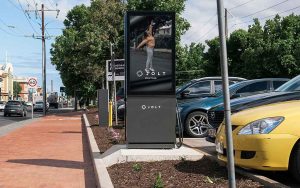Five practical design lessons for new EV charging stations
Discussions about designing charging points often focus on big picture items, like how many do we need across Australia, but what about the detail of designing an effective charging layout.

A new report from EV charging service provider JOLT provides valuable information for designers of charging stations.
The JOLT Lessons Learnt – Final Report is part of the ARENA supported Metro Advertising Revenue Funded Electric Vehicle Charging Trial.
The $2 million trial, supported by $984,000 ARENA funding, tested operations in 21 locations in and around Adelaide.
The project tested whether drivers could charge their EVs with up to 7 kWh (equivalent to about 45 km driving distance) for free, with costs covered by revenue from display advertising at each charger.
But the final report includes five key findings which could be useful for any future EV charging service models.
Customer service is vital
This goes beyond the customer’s experience during individual charging sessions.
JOLT found that providing customers with information around support, charging instructions or troubleshooting times, significantly reduced customer contact with JOLT’s support services.
Setting up active and consistent communication channels allowed JOLT to provide updates, notifications, and important information related to charging services, such as maintenance schedules, service disruptions, or new features.
Clearly mark parking bays
Public EV charging points worldwide are plagued by ICEing. That’s an industry term to describe when a vehicle with an Internal Combustion Engine (ICE) occupies an EV charging spot.
JOLT found that council-erected signs were not enough. It was only when the parking bay itself was painted with highly visible green and white markings that the project saw a significant decline in ICEing across the network.
The benefits include improved safety, space efficiency and consumer experience. But one extra effect any errant ICE driver should note, it also made parking rules more easily enforced.
Don’t skimp on the length of charging cables

The location of charging ports on different EV models varies widely.
For instance, the Tesla Model 3’s charging port is on the back right of the vehicle, whereas the Audi E-Tron’s is the front right, and the Hyundai Kona Electric charges from the front centre of the vehicle.
Also, some drivers prefer to park nose first, while others reverse into parking bays.
A salutary lesson learnt early was that four-metre cables, were too short. JOLT responded by updating cable lengths to seven metres.
Wheel stops are crucial
For such a simple device, low wheel stops delivered a bunch of benefits.
From preventing collisions with charging infrastructure, to providing correct alignment and distancing for safe and efficient charging, wheel stops really work.
Install remote monitoring capabilities
JOLT’s Adelaide charging network evolved over time to include a range of remote checks on its performance.
Remote monitoring developed beyond maintenance and diagnostics checks designed to improve network reliability. Real-time measurements deliver data for analysis to improve the service.
By understanding usage patterns, service providers can more accurately predict demand, which in turn offers opportunities to integrate renewable energy sources into the charging network.
This report and others are available via ARENA’s searchable Knowledge Bank.
LIKE THIS STORY? SIGN UP TO OUR NEWSLETTER

Andrew Webster